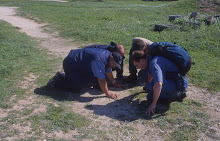Etruscan is
either cosnidered a language isolate, together with two closely related
languages (Rhaetic and Lemnian) or loosely related to Anatolian Indoeuropean
languages such as Hittite. The relationships with Indoeuropean languages are
many: numerals such as semph (seven)
and numph (nine), words such as lautun (people = populus, Leute, liudi),
and in particular many morphological items such as the genitive in –s, the
locative in –thi. Nonetheless, they are outbumberd by strong discordances: for
instance the words mach (five) and clan (son). In phylogeny, an animal that
shares characteristics of different groups is typical of transitional types.
For instance, Hippopothamus is very different from Cetaceans, even fossil Cetaceans,
and yet has been shown that Artiodactyls, to whom Hippopotamus belongs and
Cetaceans are in fact two grades of the same order Cetarctiodactylans, and
Hippopothamus is exactly the “missing link” between the two (the morphology is
of cow, but it lives in water).
In my
opinion – and this is nothing new, it is for instance more or less the same opinion
of Francisco Vilar in his “the Inodeuropeans and the origin fo Europe” – Indo-European
is a fairly recent and rather
homogeneous branch in a larger family that comprises Anatolian languages and a
number of preindoeuropean languages, among which possibly the Tartessian, the
Pelasgian, possibly the language of hydronims of Northern Europe studied by
Krahe, and appunto the Etruscan. These branches were diverging, with different
morphologies and lexicon, and yet had a common origin in the so called
Nostratic. Possibly also Anatolian languages such as Hittite and Luwian , that
diverge in so many grammatical and lexical ways from the reconstructed Protoindoeuropean,
represent one separete branch of this original radiation. The situation, in
other words, is analogue to Semitic languages, one of the traditional
linguistic families, that has been shown to belong to a larger Afro-Asiatic
familiy that comprises also Berber, Somali etc. The hypothesis of an
agricultural and matriarchal pre Indoeuropean Europe worshipping a Great Mother
– as suggested by Marija Gimbutas - that was replaced by steppe people speaking
Indoeuropean languages would be thus the history of the replacement of older
and newer branches in the same large linguistic family.
Basque,
that has often been related to the languages of Old Europe (pelasgian,
etruscan, etc.), seems instead completely isolated – it is in any way unrelated
to Etruscan.


Nessun commento:
Posta un commento